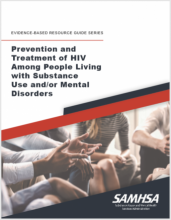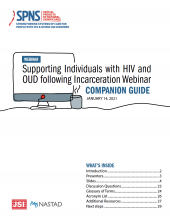
This newly released national strategy confronts the rising rates of opioid and non-opioid related fatal overdoses.



This newly released national strategy confronts the rising rates of opioid and non-opioid related fatal overdoses.
This document describes the critical role that peers have in developing and delivering care for people with HIV and OUD and how a state’s Medicaid program can serve as an essential fiscal resource in supporting peer services.
This discussion guide is intended to elicit a comprehensive and concrete conversation about language, stigma, and discrimination as a means of strengthening care systems and ensuring that people who seek care for HIV and/or substance use disorders, including opioid use disorder, are treated with
This month’s Connecting Care episode continues the conversation about barriers to methadone treatment for patients, stigma, and what we can learn from other countries to advance policy and practice for methadone in the US.
This month’s Connecting Care episode discusses the challenges associated with entering and staying in methadone treatment programs and opportunities to improve treatment experiences for all.
A recent study published in Drug and Alcohol Dependence found evidence for racial/ethnic disparities in buprenorphine distribution across the United States.
This glossary includes terms describing key concepts and components of the HIV and opioid use disorder (OUD) care and treatment systems.
This month’s Connecting Care episode discusses the impact of structural racism at the intersection of HIV and OUD care and opportunities to think outside of the box to effect change.
For Boston Health Care for the Homeless nurse Megan Sonderegger, providing client-centered care means literally meeting her clients where they are.
In recent years, the gap in the rate of opioid overdoses among Black and white Americans has narrowed significantly, with increases in Black mortality driven in part by the addition of synthetic opioids to other drugs.